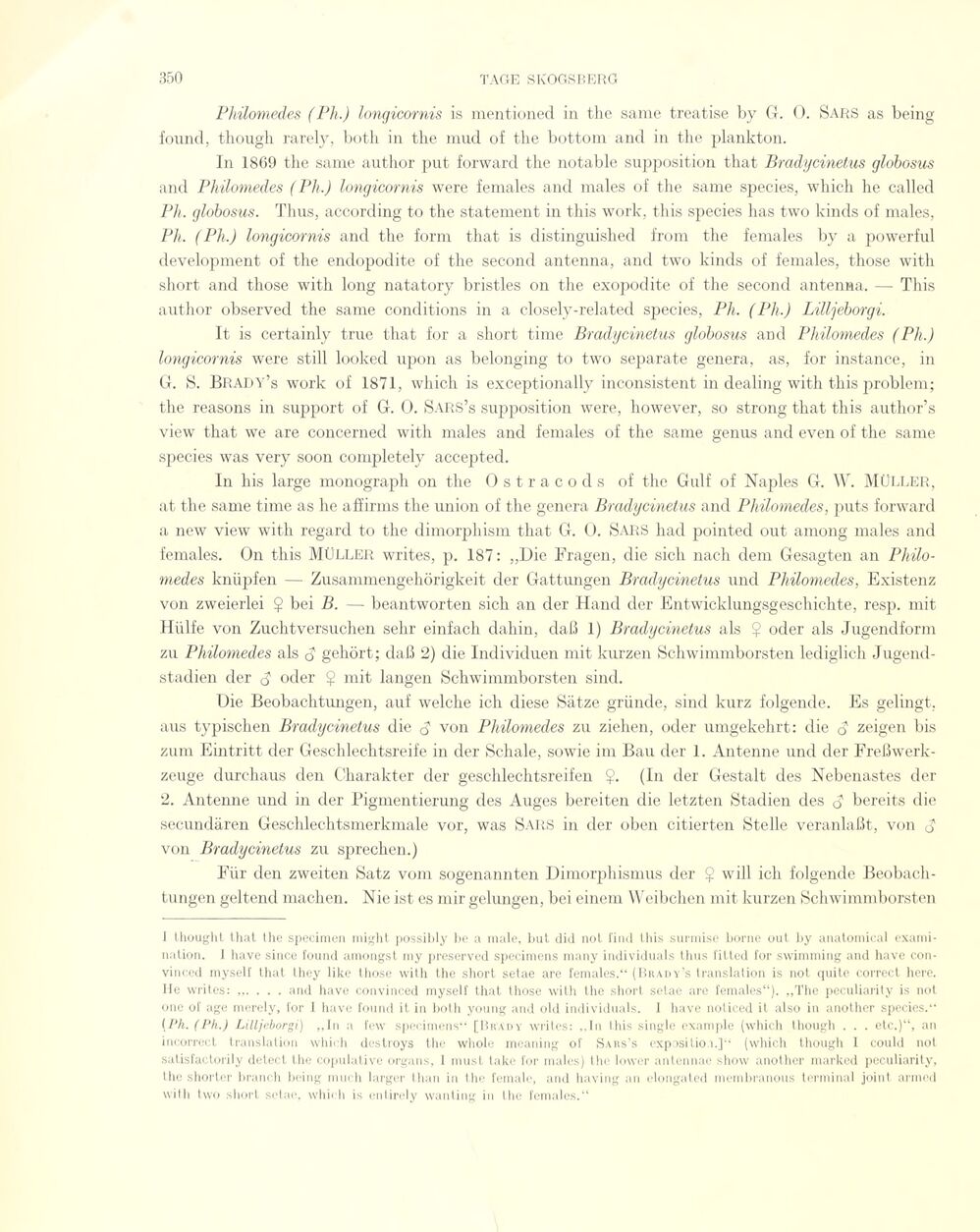
Full resolution (JPEG) - On this page / på denna sida - Sidor ...

<< prev. page << föreg. sida << >> nästa sida >> next page >>
Below is the raw OCR text
from the above scanned image.
Do you see an error? Proofread the page now!
Här nedan syns maskintolkade texten från faksimilbilden ovan.
Ser du något fel? Korrekturläs sidan nu!
This page has never been proofread. / Denna sida har aldrig korrekturlästs.
Philomedes (Ph.) longicornis is mentioned in the same treatise by Gr. O. Sars as being
found, thougli rarely, both in the mud of tlie bottom and in the plankton.
In 1869 the same author put forward the notable supposition that Bradycinetus globosus
and Philomedes ( Ph.) longicornis were females and males of the same species, which he called
Ph. globosus. Thus, according to the statement in this work, this species has two kinds of males,
Ph. (Ph.) longicornis and the form that is distinguished from the females by a powerful
development of the endopodite of the second antenna, and two kinds of females, those with
short and those with long natatory bristles on the exopodite of the second antenna. — This
author observed the same conditions in a closely-related species, Ph. (Ph.) Lilljeborgi.
It is certainly true that for a short time Bradycinetus globosus and Philomedes (Ph.)
longicornis were still looked upon as belonging to two separate genera, as, for instance, in
G. S. BRADY’s work of 1871, which is exceptionally inconsistent in dealing with this problem;
the reasons in support of G. O. SARS’s supposition were, however, so strong that this author’s
view that we are concerned with males and females of the same genus and even of the same
species was very soon completely accepted.
In his large monograph on the Ostracods of the Gulf of Naples G. W. MÜLLER,
at the same time as he affirms the union of the genera Bradycinetus and Philomedes, puts forward
a new view with regard to the dimorphism that G. O. SARS had pointed out among males and
females. On this MÜLLER writes, p. 187: „Die Fragen, die sich nach dem Gesagten an
Philomedes knüpfen — Zusammengehörigkeit der Gatt ungen Bradycinetus und Philomedes, Existenz
von zweierlei $ bei B. —- beantworten sich an der Hand der Entwicklungsgeschichte, resp. mit
Hülfe von Zuchtversuchen sehr einfach dahin, daß 1) Bradycinetus als Ç oder als Jugendform
zu Philomedes als d gehört; daß 2) die Individuen mit kurzen Schwimmborsten lediglich
Jugendstadien der d oder Ç mit langen Schwimmborsten sind.
Die Beobachtungen, auf welche ich diese Sätze gründe, sind kurz folgende. Es gelingt,
aus typischen Bradycinetus die d von Philomedes zu ziehen, oder umgekehrt: die d zeigen bis
zum Eintritt der Geschlechtsreife in der Schale, sowie im Bau der 1. Antenne und der
Freßwerk-zeuge durchaus den Charakter der geschlechtsreifen $. (ln der Gestalt des Nebenastes der
2. Antenne und in der Pigmentierung des Auges bereiten die letzten Stadien des d bereits die
secundären Geschlechtsmerkmale vor, was Sars in der oben citierten Stelle veranlaßt, von d
von Bradycinetus zu sprechen.)
Für den zweiten Satz vom sogenannten Dimorphismus der Ç will ich folgende
Beobachtungen geltend machen. Nie ist es mir gelungen, bei einem Weibchen mit kurzen Schwimmborsten
I thought that the specimen might possibly be a male, but did not find this surmise borne out by anatomical
examination. I have since found amongst my preserved specimens many individuals thus fitted for swimming and have
con-vinced myself that they like those with the short setae are females.“ (Brady’s translation is not quite correct here.
Ile writes: .......and have convinced myself that those with the short, setae are females“). „The peculiarity is not
one of age merely, for I have found it in both young and old individuals. 1 have noticed it also in another species.“
[Ph. (Ph.) Lilljeborgi) „In a few specimens“ [Br’Ady writes: „In this single example (which though . . . etc.)“, an
incorrect translation which destroys the whole meaning of Sars’s exposition.]“ (which though I could not
satisfactorily detect the copulative organs, 1 must take for males) the lower antennae show another marked peculiarity,
the shorter branch being much larger than in the female, and having an elongated membra nous terminal joint armed
with two short setae, which is entirely wanting in the formales.“
<< prev. page << föreg. sida << >> nästa sida >> next page >>